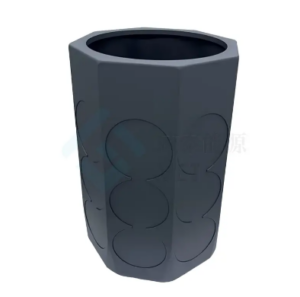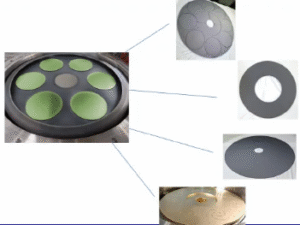
炭素繊維複合材料 は、現代工学における革命的な素材として際立っている。その卓越した強度と剛性で知られるカーボンファイバーと、構造を結合し成形する樹脂マトリックスを組み合わせたものだ。この相乗効果により、軽量なだけでなく耐久性にも優れた素材が誕生する。航空宇宙、自動車、再生可能エネルギーなどの産業は、性能と効率を高めるためにそのユニークな特性を利用している。高い強度対重量比 カーボンカーボンコンポジット 軽量化と耐久性が重視される用途には欠かせない。
要点
- 炭素繊維複合材料は 炭素繊維と樹脂マトリックス強度と軽量性を兼ね備え、優れたパフォーマンスを発揮する。
- 製造工程には、前駆体の調製、安定化、炭化、樹脂注入などの重要なステップがあり、それぞれが複合材の耐久性に寄与している。
- 炭素繊維複合材料は、航空宇宙や自動車などの産業で不可欠な高い強度対重量比を提供し、要求の厳しい用途で優れています。
- 耐腐食性と耐疲労性に優れているため、過酷な環境での使用に最適で、部品の寿命を延ばし、メンテナンスコストを削減する。
- 炭素繊維複合材料は汎用性が高いため複雑な設計が可能で、スポーツ用品から再生可能エネルギー技術まで幅広い用途に適している。
- 炭素繊維複合材料はリサイクルが可能なため、廃棄物を削減し、製造における環境に優しい慣行をサポートする。
- 寧波VET能源科技有限公司が開発をリード 先端炭素繊維複合材料業界の需要に応えるため、技術革新と持続可能性に重点を置いている。
炭素繊維複合材の主な構成要素は何ですか?
炭素繊維複合材料 炭素繊維と樹脂マトリックスである。これらの要素が一体となって、強度と軽量の両方を兼ね備えた素材を作り出している。各成分は、複合材の全体的な性能と特性を決定する上で明確な役割を果たします。
炭素繊維
炭素繊維の組成と構造
炭素繊維はグラファイト・シートでできており、炭素原子が六角形のパターンで結合している。このユニークな構造により、卓越した強度と剛性が得られる。繊維はグラファイトの小さな結晶で構成され、繊維の軸に沿って整列している。この整列が素材の機械的特性を高め、要求の厳しい用途に理想的な素材となっている。
炭素繊維の組成は、製造時に使用される前駆体材料によって異なる。一般的な前駆体には、ポリアクリロニトリル(PAN)、レーヨン、ピッチなどがある。研究により、これらの前駆体の構造と組成が炭素繊維の最終的な特性に大きく影響することが示されている。例えば、PANベースの繊維は高い引張強度で知られ、ピッチベースの繊維は優れた熱伝導性を持つ。
炭素繊維ができるまで
炭素繊維の製造にはいくつかの段階があり、まず前駆体の準備から始まる。前駆体は安定化処理を受け、化学構造を変化させて熱的に安定な状態にする。次に、不活性雰囲気中で高温に加熱する炭化工程を経る。この工程で炭素以外の元素が取り除かれ、純粋な炭素繊維が残る。
表面処理は炭化の後に行われ、繊維と樹脂マトリックスの結合を向上させる。このステップにより、複合材料の全体的な強度と耐久性が向上します。最後に、取り扱いや加工中の損傷を防ぐため、繊維に保護コーティングが施されます。
樹脂マトリックス
炭素繊維複合材料に使用される樹脂の種類
樹脂マトリックスは炭素繊維を結合させ、複合材に形状を与える。炭素繊維複合材料に使用される一般的な樹脂の種類には、エポキシ、ビニルエステル、ポリエステルなどがあります。エポキシ樹脂はその優れた機械的特性と環境要因への耐性から広く好まれている。ビニルエステル樹脂は耐薬品性に優れ、過酷な環境での用途に適しています。ポリエステル樹脂はコスト効率が高く、要求の厳しくない用途に十分な性能を発揮します。
コンポジットの特性向上におけるレジンマトリクスの役割
について レジンマトリックス は、炭素繊維全体に応力を分散させ、複合材が高荷重に耐えられるようにする上で重要な役割を果たしている。また、湿気や紫外線暴露などの環境ダメージから繊維を保護します。樹脂の柔軟性と炭素繊維の強度を組み合わせることで、複合材は耐久性と軽量性能のバランスを実現している。
さらに、樹脂マトリクスは複合材の汎用性にも貢献している。これにより、メーカーは材料を複雑な形状に成形することができ、幅広い産業での使用が可能になる。例えば、航空宇宙エンジニアは、軽量でありながら堅牢な航空機部品を設計するために、この適応性を利用している。
炭素繊維複合材はどのように製造されるのか?
について 炭素繊維複合材料の製造工程 には、一連の精密な工程が含まれる。各工程は、卓越した強度、軽量性、耐久性を備えた素材の創造に貢献する。以下は、製造工程における主要な段階の概要である。
前駆体の調製
その旅は、前駆体材料の選択と準備から始まる。ポリアクリロニトリル(PAN)は、その優れた炭化特性により、最も一般的に使用される前駆体である。ピッチやレーヨンなどの他の前駆体も利用されるが、頻度は低い。前駆体の選択は、炭素繊維の最終的な特性に大きく影響する。
炭素繊維製造における前駆体の重要性
プリカーサーは炭素繊維製造の基礎となる。繊維の機械的特性、熱安定性、そして全体的な性能を決定する。例えば、PAN系前駆体からは高い引張強度を持つ繊維が得られ、ピッチ系前駆体からは優れた熱伝導性を持つ繊維が得られる。前駆体の調製工程では、ファイバースピニングと呼ばれる方法で前駆体を細長い繊維に紡糸する。この工程により、均一性と一貫性が確保され、その後の工程に不可欠となる。
安定化
前駆体繊維が調製されると、安定化処理が施される。この工程は繊維を化学的に変化させ、熱的に安定させ、高温処理中に溶融しにくくする。
安定化プロセスと生産における役割
安定化には、酸素が豊富な環境で繊維を200℃から300℃の温度で加熱することが必要である。この過程で、繊維の原子構造は直線的な結合から、より熱的に安定したはしご状の結合へと変化する。空気中の酸素分子が繊維と相互作用し、原子構造の再配列を引き起こす。この段階は、繊維を炭化の高熱に対応させるために非常に重要である。安定化しなければ、次の段階で繊維の構造的完全性が失われてしまう。
炭化
安定化の後、繊維は炭化に移る。この段階では、繊維を不活性雰囲気中で超高温にさらすことが必要で、通常は1,000℃を超える。その目的は、炭素以外の元素を除去し、炭素原子を主成分とする素材を作り出すことである。
高温処理による炭素繊維の形成
炭化の際、繊維は加熱炉で加熱される。
表面処理
表面処理は、炭素繊維複合材料の性能を高める上で重要な役割を果たします。この工程は、炭素繊維と樹脂マトリックスとの結合を改善することに重点を置き、複合材が最大限の強度と耐久性を達成できるようにします。
繊維と樹脂の接着性向上
炭素繊維の表面は比較的不活性であるため、樹脂マトリックスとの効果的な接着を妨げる可能性がある。この問題に対処するため、メーカーは繊維の表面特性を変える表面処理を施している。このような表面処理には、表面粗さを大きくしたり、樹脂との相溶性を高める官能基を導入したりするための化学的または物理的処理が含まれることが多い。
一般的な方法の一つは、オゾンなどのガスや硝酸などの液体を用いて繊維表面を酸化させることである。この酸化プロセスは、カルボキシル基やヒドロキシル基などの極性官能基を繊維表面に導入します。これらの基は繊維と樹脂の化学的相互作用を向上させ、より強固な結合をもたらします。
別のアプローチとしては、繊維をプラズマ環境にさらすプラズマ処理がある。この技術は繊維表面を清浄化するだけでなく、活性化させ、接着力をさらに高める。繊維と樹脂の接着を向上させることにより、表面処理によって複合材料は機械的ストレスや環境上の課題に耐えることができる。
樹脂注入と硬化
炭素繊維複合材の製造工程の最終段階には、樹脂の注入と硬化が含まれる。これらの段階は、複合材を成形し、その構造を固めるために重要です。
繊維への樹脂の塗布
樹脂注入では、炭素繊維を樹脂マトリックスで飽和させる。このステップにより、樹脂が繊維層を完全に被覆・浸透し、均一な複合材料が形成される。製造業者はしばしば、真空支援樹脂トランスファー成形(VARTM)やハンドレイアップ法などの技術を使用してこれを実現します。
VARTMでは、炭素繊維を金型に入れ、真空を適用して樹脂を繊維層に引き込む。この方法は、エアポケットを最小限に抑え、樹脂の均一な分布を保証します。適切な樹脂の塗布は、複合材料の望ましい機械的特性と構造的完全性を達成するために不可欠です。
硬化プロセスとその意義
レジン注入後、コンポジットレジンを固化させ、ファイバーに接着させるプロセスである硬化が行われる。硬化には通常、使用される樹脂の種類に応じて、複合材を熱または紫外線(UV)にさらす必要がある。例えば、エポキシ樹脂の場合、硬化反応を開始させるために高温を必要とすることが多い。
硬化中、樹脂は化学変化を起こし、液体から固体に変化する。この変化により炭素繊維が固定され、剛性と耐久性のある構造が形成される。硬化プロセスはまた、湿気や温度変化などの環境要因に対する複合材の耐性を高める。
樹脂の注入と硬化を注意深く制御することで、炭素繊維複合材は最適な性能を発揮し、航空宇宙産業や自動車産業などの要求の厳しい用途に適しています。
炭素繊維複合材料の主な特性は?
強度と剛性
従来の素材に比べ優れた性能
カーボンファイバー・コンポジットは驚くべき強度と剛性を示し、スチールやアルミニウムのような従来の素材よりも優れた選択肢となる。複合材料内の炭素繊維は特定の方向に整列し、変形することなく大きな荷重に耐えることができます。この整列によって材料の引張強度が向上し、他の材料では通常破損してしまうような力にも耐えることができます。
例えば、航空宇宙用途では、エンジニアは炭素繊維複合材を使って航空機の翼や胴体を組み立てている。これらの部品は飛行中に莫大な応力に耐えますが、炭素繊維複合材はその構造的完全性を維持します。また、その剛性により、空力効率を維持するために重要なたわみを最小限に抑えることができます。この強度と剛性の組み合わせにより、この素材は高性能のソリューションを必要とする産業にとって不可欠なものとなっている。
軽量性
重量に敏感なアプリケーションの利点
炭素繊維複合材料の最も注目すべき特性のひとつは、その軽量性である。その卓越した強度にもかかわらず、スチールやチタンのような金属よりも重量が大幅に軽い。この特性は、軽量化が重要な産業において非常に貴重なものとなっています。
自動車分野では、軽量な自動車フレームやパネルを製造するために炭素繊維複合材が使用されている。車両の重量を減らすことで、燃費を向上させ、全体的な性能を高めることができる。同様に、自転車やテニスラケットなどのスポーツ用品においても、複合材の軽量性により、アスリートはより優れたスピードとコントロールを達成することができる。
製造に使用される樹脂注入プロセスは、材料の重量をさらに最適化する。真空アシスト樹脂トランスファー成形(VARTM)のような技術は、余分な樹脂の使用を最小限に抑え、最終製品が可能な限り軽量であることを保証します。繊維と樹脂の間のこの慎重なバランスは、重量が重視される用途における複合材料の比類ない性能に貢献している。
耐腐食性と耐疲労性
厳しい環境下での耐久性
炭素繊維複合材は耐腐食性と耐疲労性に優れ、過酷な条件下でも高い耐久性を発揮します。湿気や化学薬品にさらされると腐食する金属とは異なり、複合材は非金属であるため影響を受けません。この特性により、この素材から作られた部品の寿命が延び、メンテナンス・コストとダウンタイムが削減される。
例えば海洋環境では、炭素繊維複合材は船体や水中構造物の建造に使用されている。このような用途では、常に海水にさらされても劣化しない素材が求められます。炭素繊維複合材は腐食に強いため、長期間にわたって信頼性の高い性能を発揮します。
さらに、この素材は繰り返される応力サイクルによる疲労にも強い。従来の材料は、このような条件下では弱くなったり破損したりすることが多かったが、炭素繊維複合材は強度と機能性を維持する。この耐久性により、風力タービンブレードのような、様々な気象条件下で継続的な機械的ストレスに耐える用途に適しています。
熱伝導率および電気伝導率
炭素繊維複合材料のユニークな特徴
炭素繊維複合材はユニークな熱伝導性と電気伝導性を示す プロパティ多くの伝統的な素材とは一線を画している。炭素繊維はグラファイト・シートで構成され、炭素原子が六角形のパターンで並んでいる。この配列が電子の動きを容易にし、素材の導電性に寄与している。
熱伝導性に関しては、炭素繊維複合材料は、製造時に使用される前駆体の種類によって様々な性能を示す。例えば、ピッチ系炭素繊維は黒鉛化度が高いため、熱伝導に優れています。この特性は、電子部品や熱交換器など、効率的な熱放散を必要とする用途に適している。エンジニアはしばしばこの能力を利用して機器の過熱を防ぎ、最適な性能と寿命を確保する。
炭素繊維複合材の電気伝導性も大きな利点である。銅やアルミニウムのような金属に比べれば低いレベルではあるが、この素材は電気を通すことができる。この特性は、軽量な導電性素材が不可欠な航空宇宙や自動車などの産業において有益であることが証明されています。例えば、炭素繊維複合材は、繊細な機器を干渉から守るための電磁シールドに使用されています。また、その導電性により、電荷を安全に放散する航空機の落雷保護などの用途にも使用されています。
このような利点があるにもかかわらず、炭素繊維複合材料の導電性は、特定の要件を満たすように調整することができます。製造業者は、樹脂マトリックスを調整したり、追加材料を組み込んだりすることでこれを実現する。例えば、絶縁性樹脂を加えることで導電率を下げ、非導電性の用途に適したコンポジットにすることができる。逆に、炭化の際に黒鉛化プロセスを強化することで、特殊な用途向けに導電性を高めることができる。
このような熱的・電気的特性と、軽量で耐久性に優れていることから、炭素繊維複合材料は、現代のエンジニアリングの課題に対して多用途な選択肢となっています。その適応性により、革新的な解決策を求めるあらゆる産業において、炭素繊維複合材はその関連性を保ち続けています。
炭素繊維複合材の利点は何ですか?
要求の厳しい用途で高い性能を発揮
炭素繊維複合材料は、卓越した強度と耐久性を必要とする用途に優れています。その高い引張強度は、鋼鉄やアルミニウムのような従来の素材を凌ぐ。例えば、炭素繊維は鋼鉄の最大5倍の強度と2倍の剛性を持ちながら、重量は かなり少ない.この強度対重量比は、応力下での性能が重要な航空宇宙や自動車などの産業に理想的である。
航空宇宙分野では、エンジニアは航空機の主翼や胴体の製造に炭素繊維複合材を使用している。これらの部品は飛行中の極端な力に耐えるが、素材は構造的完全性を維持する。同様に、自動車分野では、軽量でありながら頑丈な自動車フレームを製造するために炭素繊維が使用されています。これにより車両重量が軽減され、安全性を損なうことなくスピードと燃費が向上します。軽量でありながら高荷重に耐えることができる炭素繊維は、過酷な環境においても優位性を発揮します。
設計と製造における多様性
炭素繊維複合材料は、設計と製造において比類のない柔軟性を提供します。その適応性により、エンジニアは複雑な形状に成型することができ、様々な産業における革新的なソリューションを可能にします。大規模な機械加工を必要とすることが多い金属とは異なり、炭素繊維は廃棄物を最小限に抑えながら特定の寸法に調整することができます。
例えば、スポーツ業界では、自転車、テニスラケット、ゴルフクラブなどの高性能機器の製造に炭素繊維が使用されている。これらの製品は、素材の軽量性と強度の恩恵を受けて、ユーザーのパフォーマンスを向上させている。再生可能エネルギーの分野では、炭素繊維の多用途性が、精度と耐久性の両方が要求される大型風力タービンブレードの製造を支えている。
製造工程も汎用性を高めている。真空アシスト樹脂トランスファー成形(VARTM)のような技術は、均一性と精度を保証し、複雑なデザインに適しています。この適応性は、ロボット工学や医療機器など、特注の形状やサイズが不可欠な産業にも及んでいる。炭素繊維複合材が多様な設計要件に対応できることは、現代のエンジニアリングにおける炭素繊維複合材の価値を裏付けています。
持続可能性とリサイクル性
炭素繊維複合材は、その長い寿命とリサイクル可能性により、持続可能性に貢献しています。腐食や疲労に強いため、頻繁な交換の必要性が減り、長期にわたる廃棄物を最小限に抑えることができます。従来の素材とは異なり、炭素繊維は長期間使用してもその特性を維持するため、費用対効果が高く、環境に優しい選択肢となります。
炭素繊維のリサイクル工程は著しく進歩している。メーカーは現在、使用済みの複合材から繊維を回収し、新たな用途に再利用している。これにより、生産に伴う環境への影響が軽減され、持続可能な実践を推進する世界的な取り組みと一致する。例えば、リサイクルされた炭素繊維は自動車部品、消費財、建設資材などに使用されています。
さらに、炭素繊維複合材は軽量であるため、エネルギー効率も向上する。交通機関では、車両が軽量化されることで燃料消費量が減り、温室効果ガスの排出量が削減される。炭素繊維で作られた風力タービンは再生可能エネルギーを生み出し、環境保護にさらに貢献します。性能と持続可能性を両立させることで、炭素繊維複合材は、さまざまな産業で高まる環境に優しい素材への需要に対応している。
炭素繊維複合材料の用途は?
炭素繊維複合材は、強度、軽量性、多用途性というユニークな組み合わせにより、現代の産業を一変させました。その用途は、性能、効率、耐久性が最重要視されるあらゆる分野に及んでいます。
航空宇宙産業
航空機の構造および部品への使用
航空宇宙産業は、航空機の主翼、胴体、尾翼などの重要な部品を構成するために炭素繊維複合材に大きく依存しています。エンジニアは、炭素繊維複合材の高い 強度重量比これにより、航空機は全体的な重量を減らしながら優れた性能を達成することができる。この軽量化は直接的に燃料効率を改善し、積載量を増加させる。
例えば、民間航空機メーカーは、飛行中の莫大な空力力に耐える軽量かつ堅牢な翼を設計するために炭素繊維複合材を使用しています。戦闘機や宇宙船も、高い応力や温度変化などの過酷な条件に耐えるこの素材の恩恵を受けています。その剛性により、構造部品はその形状を維持し、空力効率と安全性が向上します。
事実:炭素繊維複合材は鋼鉄の5倍もの強度を持ちながら、重量は大幅に軽いため、航空宇宙用途には欠かせない。
自動車産業
燃費向上のための軽量素材
自動車分野では、炭素繊維複合材は次のような製品を製造する上で極めて重要な役割を果たしている。 軽自動車 燃料消費量が少ない。自動車メーカーは、安全性や耐久性を損なうことなく軽量化を図るため、この素材を自動車のフレーム、ボディパネル、内装部品に組み込んでいる。この素材により、自動車メーカーは燃費を改善し、二酸化炭素排出量を削減することで、厳しい環境規制を満たすことができる。
高性能スポーツカーのシャシーやエクステリアには、カーボンファイバー・コンポジットが採用されていることが多い。その強度は、構造的な完全性を維持しながら高速走行や急旋回に対応することを可能にしている。電気自動車(EV)も、軽量化によってバッテリーの航続距離を延ばし、全体的な効率を高めることができるため、この素材の恩恵を受けています。
例:ある高級スポーツカーメーカーは、モノコック構造のシャシーにカーボンファイバー・コンポジットを採用。
スポーツとレクリエーション
自転車やテニスラケットなどの高性能用具
アスリートやスポーツ愛好家にとって、炭素繊維複合材を使用した高性能器具は有益である。その軽量性と剛性は、スピード、コントロール、精度を向上させ、ユーザーに競争力を与えます。この素材から作られた自転車は操作や加速がしやすく、プロのレースやマウンテンバイクに理想的です。
カーボンファイバー・コンポジットで作られたテニスラケットは、パワーが強化され、振動が減少し、プレーヤーのパフォーマンスと快適性が向上します。ゴルフクラブ、フィッシングロッド、ホッケースティックも、最適なバランスと耐久性を実現するためにこの素材を利用しています。その適応性により、メーカーは特定のスポーツに合わせたカスタム設計を行うことができ、最大限の効率を確保することができます。
洞察:炭素繊維複合材は、応力下での変形に強いため、安定した性能を要求されるスポーツ用品に適しています。
再生可能エネルギー
風力タービンブレードとグリーンテクノロジーにおける役割
炭素繊維複合材は、再生可能エネルギー技術の進歩において極めて重要な役割を果たしている。その軽量性と卓越した強度は、風力タービンのブレードを構成するのに理想的な素材です。これらのブレードは、絶え間ない機械的ストレスや、強風や温度変化などの過酷な環境条件に耐えなければなりません。炭素繊維複合材は、極度の荷重下でもブレードの構造的完全性を維持しながら耐久性を確保します。
炭素繊維複合材の高い剛性により、風力タービンのブレードは、効率的なエネルギー生成に不可欠な空気力学的形状を維持することができます。エンジニアは、この素材を使ってより長く効率的なブレードを設計し、風力タービンのエネルギー出力を増加させます。例えば、カーボンファイバー・コンポジット製のブレードを使用した最新の風力タービンは、グラスファイバーのような従来の素材を使用したものに比べ、発電量が大幅に増加します。
風力タービンのみならず、炭素繊維複合材は他のグリーンテクノロジーにも貢献している。炭素繊維複合材は、ソーラーパネルやエネルギー貯蔵システムの軽量部品の製造に使用されています。これらのシステムを軽量化することで、メーカーは輸送性や設置効率を向上させることができます。さらに、この材料の耐腐食性は長期的な性能を保証し、再生可能エネルギー用途における持続可能な選択肢となっています。
事実:炭素繊維複合材で作られた風力タービンのブレードは、従来の材料で作られたものよりも重量が30%も軽くなり、より高い効率と運転コストの削減が可能になります。
医療用および工業用
義肢装具とロボット工学への応用
炭素繊維複合材料は、そのユニークな特性により、医療および産業分野に革命をもたらした。義肢装具では、この素材は軽量でありながら強靭なソリューションを提供します。義肢装具の軽量化により、患者は可動性と快適性の向上という恩恵を受けることができます。炭素繊維複合材の高い剛性は、これらの器具が変形することなく繰り返し応力に耐えることを保証し、長持ちする性能を提供します。
ロボット工学もまた、高度な部品を作るために炭素繊維複合材に大きく依存している。ロボットアームやジョイントには、強度と精度を兼ね備えた材料が必要です。炭素繊維複合材は、高い引張強度と低い熱膨張を提供することで、これらの要求を満たします。これにより、ロボットシステムは厳しい環境下でも精度と信頼性を維持することができます。
産業用途では、炭素繊維複合材は機械や工具の性能を高めます。疲労や腐食に強いため、製造工場や海上施設などの過酷な条件下での使用に適しています。例えば、水中探査に使用されるロボットシステムには、耐久性と効率性を確保するために炭素繊維複合材が使用されています。
洞察:炭素繊維複合材で作られた義肢は、軽量であるだけでなく耐久性も高いため、ユーザーは日常生活をより楽に、自信を持って行うことができます。
寧波VETエネルギー技術有限公司は炭素繊維複合材業界にどのように貢献しているのか?
先端材料の専門知識
寧波VET能源科技有限公司は、浙江省寧波市の寧波VET能源科技有限公司と合弁で設立された。 新素材.同社は、さまざまな業界のニーズに合わせた高性能炭素繊維複合材料の開発・製造を専門としている。最先端技術と広範な研究を活用することで、同社製品は卓越した強度、剛性、軽量特性を実現している。
寧波VETエネルギー技術有限公司のチームは、炭素繊維製造と複合材製造プロセスに関する深い知識を持っています。この専門知識により、同社は鉄やアルミニウムのような従来の材料を凌駕する革新的なソリューションを生み出すことができる。例えば、同社の炭素繊維複合材料は、優れた機械的特性が不可欠な航空宇宙および自動車用途で広く使用されている。
事実:炭素繊維複合材料は、鋼鉄の最大5倍の強度を持ちながら、大幅に軽量であるため、高性能を必要とする産業に理想的である。
イノベーションと持続可能性への取り組み
イノベーションが寧波VETエネルギー技術有限公司の成功の原動力である。同社は炭素繊維複合材料の性能と汎用性を向上させるため、研究開発に継続的に投資しています。業界のトレンドを先取りすることで、現代工学の進化する要求に対応する新製品を発表しています。
持続可能性は、寧波VETエネルギー技術有限公司の中核的な焦点であり続けている。同社は生産工程全体で環境に優しい手法を採用し、廃棄物を最小限に抑え、環境への影響を低減しています。また、使用済み複合材から炭素繊維を回収して再利用する方法を開発することで、リサイクルの取り組みも支援しています。こうした取り組みは、持続可能な素材を推進し、二酸化炭素排出量を削減するという世界的な目標に沿ったものである。
洞察:リサイクル炭素繊維複合材料は、自動車部品や消費財にますます使用され、循環型経済に貢献している。
様々な産業向けの製品とソリューション
寧波VETエネルギー技術有限公司は、複数の業界向けに設計された炭素繊維複合材料の多様な製品を提供しています。そのソリューションは、航空宇宙、自動車、再生可能エネルギー、スポーツ用品、医療機器などの分野に対応しています。各製品は、特定の性能要件を満たすように設計されており、信頼性と効率を保証します。
航空宇宙産業では、航空機の構造や部品に軽量かつ耐久性のある複合材を提供している。自動車メーカー各社は、排出ガスを抑えた低燃費の自動車を製造するために、同社の素材を利用している。再生可能エネルギー分野では、同社の炭素繊維複合材料が風力タービンブレードの性能を高め、より高いエネルギー出力を可能にしている。
寧波VETエネルギー技術有限公司の製品の汎用性は、スポーツやレクリエーションにも及んでいる。同社の複合材料で作られた高性能自転車、テニスラケット、ゴルフクラブは、アスリートにスピード、コントロール、耐久性の向上を提供している。さらに、医療分野では、義肢装具やロボットシステムに使用される軽量で丈夫な素材が役立っている。
例:寧波VETエネルギー技術有限公司の炭素繊維複合材料で作られた風力タービンブレードは、重量が軽く、長持ちするため、効率が向上し、運転コストが削減される。
寧波VET能源科技有限公司は、専門知識、技術革新、持続可能性へのコミットメントを組み合わせることで、炭素繊維複合材産業の発展に極めて重要な役割を果たしています。寧波VET能源科技有限公司の製品は、環境問題に取り組みながら、産業界がより高いパフォーマンスを達成できるよう支援しています。
連絡先
寧波VET能源科技有限公司は、炭素繊維複合材料を利用する産業に包括的なサポートとソリューションを提供します。同社は、プロジェクトのための先端材料を求める企業からの問い合わせやコラボレーションを歓迎します。下記はお問い合わせ先です:
- 電話: 86-1891 1596 392
- 電子メール: yeah@china-vet.com
- 住所:315201 中国浙江省寧波市鎮海区中関西路777号
- 担当者:ゼネラルマネージャー
製品やサービスの詳細については、公式ウェブサイトをご覧ください: http://weitai1.globaldeepsea.site/.ウェブサイトでは、彼らの専門知識、革新的なソリューション、持続可能性へのコミットメントについて詳しく紹介している。
チップ:航空宇宙、自動車、再生可能エネルギー、およびその他の分野の企業は、寧波VETエネルギー技術有限公司に直接お問い合わせいただくことで、オーダーメイドのソリューションを検討することができます。彼らの専門家チームは、高品質の材料と卓越した顧客サービスを保証します。
寧波VET能源科技有限公司は、炭素繊維複合材産業の発展に尽力しています。寧波VET能源科技有限公司は、炭素繊維複合材業界の発展に尽力しています。
炭素繊維複合材は、炭素繊維と樹脂マトリクスを組み合わせることで、比類のない強度、軽量特性、多用途性を実現する、材料科学における画期的な製品です。前駆体の調製から樹脂の注入に至るまで、綿密な製造工程がその優れた性能を保証している。航空宇宙、自動車、再生可能エネルギーなどの業界では、耐久性と効率の高さからこの素材に信頼を寄せています。寧波VETエネルギー技術有限公司は、持続可能性を優先しながら先進的なソリューションを提供し、炭素繊維業界の革新を推進し続けています。同社の専門知識は、環境に優しい材料で高性能目標を達成する産業をサポートしています。
よくあるご質問
炭素繊維複合材料が従来の材料に比べてユニークなのはなぜですか?
炭素繊維複合材料 炭素繊維複合材料は、その卓越した強度、剛性、軽量特性によって際立っています。鉄やアルミニウムのような従来の材料とは異なり、炭素繊維複合材料は優れた強度対重量比を提供します。そのため、航空宇宙、自動車、再生可能エネルギーなど、耐久性を損なうことなく軽量化を図ることが重要な産業に最適です。さらに、腐食や疲労に対する耐性により、厳しい環境下でも長期的な性能を発揮します。
事実:炭素繊維複合材料は、鋼鉄の最大5倍の強度を持ちながら、重量は大幅に軽い。
炭素繊維複合材料は医療用途に安全か?
はい、炭素繊維複合材料は医療用としても安全です。これらの素材は無毒性で生体適合性があるため、補綴物やインプラント、手術器具に適しています。また、X線を透過するため、医療用画像診断や診断に役立ちます。この特性により、炭素繊維を使用した器具が医療処置の妨げになることはありません。
例:炭素繊維複合材料で作られた義肢は、患者に以下のものを提供する。 軽量で耐久性のあるソリューション機動性と快適性を向上させる。
炭素繊維複合材料は航空宇宙産業でどのように使われているのか?
航空宇宙産業は、航空機の主翼や胴体、その他の構造部品を構成する炭素繊維複合材料に依存している。これらの素材は航空機全体の重量を減らし、燃料効率と積載量を向上させます。その高い剛性により、極度の空気力学的な力が加わっても部品の形状が維持され、安全性と性能が向上します。
洞察:現代の民間航空機は、炭素繊維複合材を採用することで軽量化を実現し、燃料の大幅なコスト削減を実現している。
なぜ炭素繊維複合材料がスポーツ用品に好まれるのか?
炭素繊維複合材料は、その軽量かつ高性能な特性により、スポーツ用品に広く使用されている。炭素繊維複合材料は、自転車、テニスラケット、ゴルフクラブなどの製品において、スピード、コントロール性、耐久性を向上させる。アスリートは、応力下でも変形しにくく、使用中に安定したパフォーマンスを発揮できるこの素材の利点を享受している。
例:プロのサイクリストは、その優れた操縦性と加速性からカーボンファイバー製自転車を選ぶことが多い。
炭素繊維複合材料はリサイクル可能か?
はい、炭素繊維複合材料はリサイクルできます。高度なリサイクル方法により、使用済みの複合材から繊維を回収し、新たな用途に再利用します。このプロセスは廃棄物を削減し、持続可能性への取り組みをサポートします。リサイクルされた炭素繊維は、自動車部品、消費財、建設資材などによく使用されています。
事実:炭素繊維複合材料のリサイクルは、環境への影響を最小限に抑え、資源効率を促進することで、循環型経済に貢献します。
再生可能エネルギーにおいて炭素繊維複合材料が果たす役割とは?
炭素繊維複合材料は、再生可能エネルギー、特に風力タービンのブレード建設において重要な役割を果たしている。軽量で強度が高いため、ブレードをより長く効率的に使用することができ、エネルギー出力が向上する。この素材は環境要因に強いため、過酷な条件下でも耐久性が保証される。
洞察:炭素繊維複合材料で作られた風力タービンブレードは、重量が軽く長持ちするため、運転コストを削減し、効率を向上させる。
炭素繊維複合材料は自動車の技術革新にどのように貢献するのか?
自動車産業では、炭素繊維複合材料によって、燃料消費量の少ない軽量な自動車の生産が可能になる。メーカーはこれらの素材を自動車のフレーム、ボディパネル、内装部品に使用し、燃費の向上と排出ガスの削減を図っている。高性能のスポーツカーや電気自動車は、軽量化と構造的完全性の向上から大きな恩恵を受けている。
例:ある高級スポーツカー・メーカーは、シャシーにカーボンファイバー複合材を使用することで、軽量かつ高剛性な構造を実現し、スピードとハンドリングを向上させている。
炭素繊維複合材料の熱特性と電気特性は?
炭素繊維複合材料はユニークな熱伝導性と電気伝導性を示す。ピッチ系炭素繊維は熱伝導に優れ、電子部品や熱交換器などの用途に適している。この素材は電気も通すので、航空宇宙産業や自動車産業では電磁シールドや落雷防止に役立ちます。
事実:エンジニアは、特定の用途のニーズに合わせて樹脂マトリックスや製造工程を調整することで、炭素繊維複合材料の導電性を調整することができます。
炭素繊維複合材料は環境破壊に強いか?
そう、炭素繊維複合材料は、腐食や疲労などの環境ダメージに強いのだ。金属とは異なり、湿気や化学薬品にさらされても腐食しません。この特性により、海洋環境やその他の過酷な条件に理想的です。疲労に対する耐性は、繰り返されるストレス・サイクルの下でも長期的な信頼性を保証します。
例:船舶や水中構造物には、常に海水にさらされても劣化しない炭素繊維複合材が使用されている。
寧波VET能源科技有限公司は炭素繊維複合材産業をどのようにサポートしているのか?
寧波VETエネルギー技術有限公司は、様々な産業向けの高性能炭素繊維複合材料の開発を専門としている。同社は技術革新と持続可能性に重点を置き、特定のニーズに合わせた高度なソリューションを提供している。同社の製品は、航空宇宙、自動車、再生可能エネルギー、医療機器などの分野で性能を高めている。
チップ:信頼性が高く、環境に優しい炭素繊維複合材ソリューションを求める企業は、寧波VETエネルギー技術有限公司に連絡し、専門家の指導とサポートを受けることができます。






